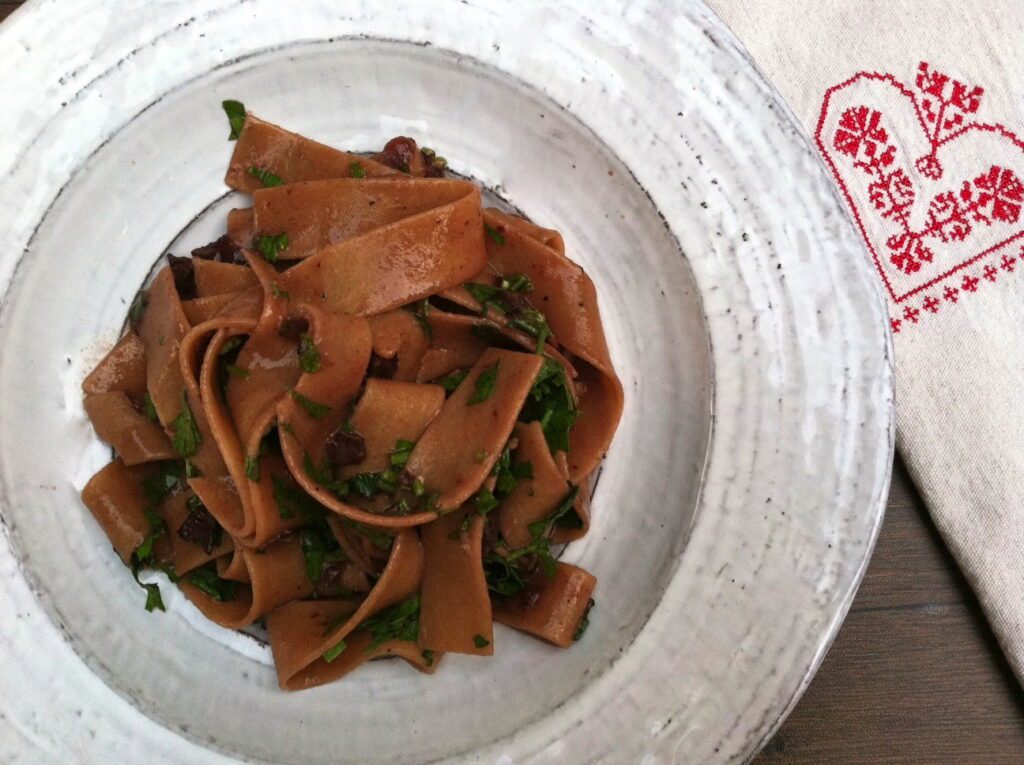
Strisce alla Chiantigiana – pappardelle in a pancetta and Chianti sauce
This combination of simple ingredients results in a complex but super-speedy umami rich red wine sauce. The Strisce alla Chiantigiana recipe originates in Florence. Close your eyes, taste this and you could be there.
This recipe serves 2, feel free to double it but for some reason I feel it is a dinner a deux rather than a family dinner so I tend to make it in a smaller size.
The pasta
Strisce means strips of pasta but you can make it with penne or another shape. In California I use whole milled pappardelle, particularly the Community Grains brand which is grown from ancient grains (more easily digested than modern wheat) and milled whole by stone, thus preserving more nutrients and keeping the full grain (unlike most things that are sold as wholegrain where the grain is split and machine ground then re-combined later). In the UK try Garofalo organic whole wheat pappardelle from Ocado. If you are gluten-free try making this with brown rice penne (from Trader Joe’s in the US or Waitrose in the UK).
The wine
Chianti Classico, from the Chianti region of Tuscany is one of my favourite wines and is made from the sangiovese grape. It is the key flavour in this pasta sauce. I have fond memories of a wine tasting and vineyard tour in Chianti with my oldest son strapped to my chest, snoozing in his Baby Bjorn when he was 4 months old. I can’t believe that was 12 years ago.

As always when cooking, buy a wine that is a pleasure to drink. You really taste the wine here, and the recipe only needs part of the bottle so you will be able to enjoy the rest of the bottle as you eat (or cook). I know, I’m sorry. In Europe go ahead and buy a good Chianti to make this. However, if you are Stateside it feels strange to import wine when there is so much growing locally – so you can make a Cali version of this by using any good, dry medium-weight red wine. I use the Globerati Sangiovese from Whole Foods. Zinfandel is a good substitute too.
The pancetta
Pancetta is the other key flavour here. You’ll find it easily in UK supermarkets. Pancetta’s closest American relative is bacon, however, whilst both pancetta and bacon are cured, pancetta is not smoked. It has a more subtle aromatic, herbal flavour. You can substitute good quality bacon into this recipe but if you are, I would probably add some chopped fresh rosemary to take it in more of an Italian direction.
Pasta cooking 101
The water you cook pasta in should be as salty as the Mediterranean sea. That way your pasta has some flavour before you add the sauce – so you need to work less hard to make everything taste amazing. A larger quantity of water gives the pasta more space to move around (to prevent sticking) and will return to a boil more quickly after the pasta is added. Don’t add oil to your pasta water – it serves no purpose and is a waste of oil.
Always, always mix your sauce into your pasta in the pan before serving. No one in Italy would ever serve plain noodles with sauce dumped on top so neither should you!
Use freshly grated Parmesan, Pecorino (sheep’s milk cheese) to finish pasta dishes – except those containing fish. Stir it through rather than just sprinkling it on top to thicken and season sauces with a salty, umami hit.
And if you only take one thing from this…
The starchy, salty liquid left in the pot after the pasta is cooked is the key to amazing pasta. The pasta water contains starch which means it helps the pasta and sauce come together in a delicious silky way. The starch becomes the bridge between the pasta and the sauce.
Before you drain cooked pasta, ladle out one-two cups of the cooking liquid and save it. A splash or two will help your sauce emulsify as you finish the pasta in the pan. Promise me you will get into the habit of holding back some of your pasta cooking water every time you cook pasta. Always keep a small cup in your colander to remind you to save some of the water rather than dump it down the sink.
Active prep time: 5 minutes. Cooking time: 15-20 minutes
Strisce alla Chiantigiana Ingredients (serves 2):
- 240g (8oz) whole grain pappardelle – see note above for which brand to buy
- 1 tablespoon grain sea salt for the pasta cooking water
- ½ red onion, thinly sliced in half moons (see my technique video here)
- 2 cloves garlic, sliced
- 120g (4oz) pancetta, cut into finger nail sized pieces
- 360ml (1½ cups) Chianti or other good, dry medium-bodied red wine (see note above)
- 100g (4oz or 1 cup) freshly grated Parmesan or Pecorino plus more for serving
- red wine vinegar to taste
- sea salt, freshly ground black pepper to taste
- a big handful of of chopped flatleaf (Italian) parsley or rocket (arugula)
To make:
- Put your pasta water and salt onto boil in your biggest pan (see note above). Put the lid on to speed up the boiling time.
- Meanwhile, put a large frying pan over a medium heat. Add the pancetta and cook, stirring occasionally, until pancetta is brown and crisp, about 5 minutes. No need to add oil as the pancetta will release oil.
- Chop the garlic and onion while the pancetta cooks then add the onion to the pancetta, stir well and cook for a further 5-8 minutes until the onion is soft. Add the garlic for the final minute of cooking. If you add it earlier it will burn as the garlic contains more sugar than onion, therefore it will burn faster. This is the case in pretty much every recipe.
- Add your pasta to the boiling water, stir then bring back to the boil with the lid half way covering the pan, before reducing the heat to a fast simmer.
- Add your wine to the onion, garlic and pancetta and bring to a boil. Then cook, stirring occasionally, until reduced by half, this should take around 8 minutes. At this stage the sauce can be made ahead and kept for 3-4 days in the fridge.
- Test your pasta, it should have a slight bite but be cooked. Drain and reserve a cup of the cooking liquid – I usually scoop some water out first before I drain it.
- Add the drained pasta to the sauce along with half of the grated Parmesan and a quarter cup (about 60ml) of the pasta water. Cook on a low heat, shaking the pan and tossing often with metal tongs, until the sauce coats the pasta. This should take about 2 minutes. Gradually add more of the cooking water as you cook to keep the sauce silky. I usually end up adding about half a cup of water in total as the pasta will keep absorbing the liquid.
- Pop a couple of serving bowls in the microwave for a minute to warm. You don’t want to serve your amazing pasta in cold bowls.
- Taste the pasta and sauce and balance the flavour by adding red wine vinegar, pepper or salt as needed. Spend your time on this bit and be brave with the vinegar. A splash of wine is nice at this stage too to add a fresher layer of the same flavour.
- Throw in your chopped rocket (arugula) or parsley once the pasta is off the heat and allow the residual heat to wilt the greens.
- Serve the pasta immediately, topped with the rest of the grated Parmesan and with a glass of wine.
Equipment
You can now buy the equipment I use in this recipe through my shop. I’ve spent years testing my favourite bits of equipment so rest-assured that whatever I recommend is the best tool for the job and will give you great results without cluttering your kitchen with unused tools. I receive a small affiliate fee from Amazon if you buy via my link. The products don’t cost you any more. These small fees help me keep creating all the free content I share.
Get more recipes like this
Find more recipes for pasta, pancetta and mid week meals here.
Sign up for more
Sign up for my free newsletter. You’ll get free seasonal recipes, tips and videos. You’ll also be first to hear about my online and in person courses.
I agree to be emailed about your products and services
